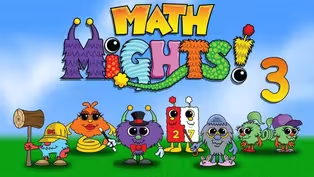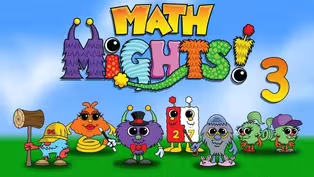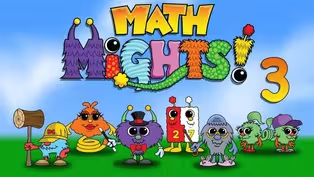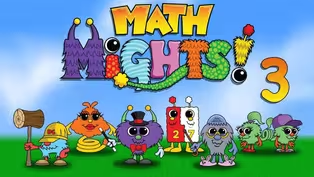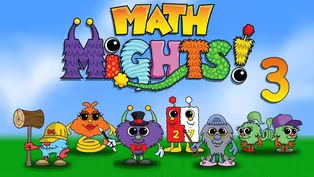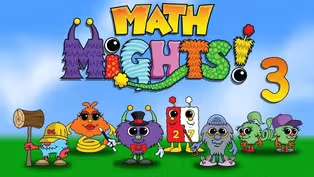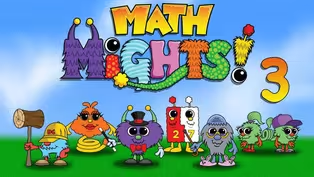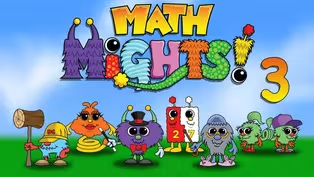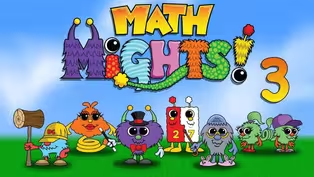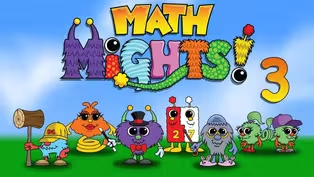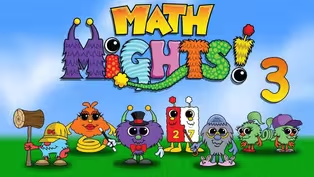Math Mights
Build Fraction from Unit Fractions
Season 3 Episode 310 | 15m 59sVideo has Closed Captions
Join Ms. Askew for another multi-step word problem with Professor Barble!
Join Ms. Askew for another multi-step word problem with Professor Barble! Next we will building fractions from unit fractions and playing a fun game called Secret Fractions!
Problems playing video? | Closed Captioning Feedback
Problems playing video? | Closed Captioning Feedback
Math Mights is a local public television program presented by Detroit PBS
Math Mights
Build Fraction from Unit Fractions
Season 3 Episode 310 | 15m 59sVideo has Closed Captions
Join Ms. Askew for another multi-step word problem with Professor Barble! Next we will building fractions from unit fractions and playing a fun game called Secret Fractions!
Problems playing video? | Closed Captioning Feedback
How to Watch Math Mights
Math Mights is available to stream on pbs.org and the free PBS App, available on iPhone, Apple TV, Android TV, Android smartphones, Amazon Fire TV, Amazon Fire Tablet, Roku, Samsung Smart TV, and Vizio.
Providing Support for PBS.org
Learn Moreabout PBS online sponsorshipMore from This Collection
Video has Closed Captions
Join Ms. Askew for a tricky multi-step word problem with Professor Barble! (15m 59s)
Video has Closed Captions
Join Ms. Askew for a division word problem with her friend Professor Barble. (15m 59s)
Video has Closed Captions
Join Ms. Askew for a division word problem with her friend Professor Barble. (16m)
Video has Closed Captions
Join Ms. Askew and Professor Barble to do a visual model with a word problem. (15m 59s)
Dividing with even larger numbers
Video has Closed Captions
Join Ms. Askew and Professor Barble to do a visual model with multiplication. (15m 59s)
Video has Closed Captions
Join Ms. Askew and Professor Barble to see if you can match visual models to word problems (15m 59s)
Dividing with Larger Quotients
Video has Closed Captions
Join Ms. Askew and Professor Barble to see if you can match visual models to word problems (15m 59s)
Video has Closed Captions
Learn about multiplying one-digit whole numbers by multiples of 10. (15m 59s)
Video has Closed Captions
Learn about multiplying numbers larger than 20. (16m)
Video has Closed Captions
Join Mrs. Askew for a Number Talk with 2 Math Might Friends! (16m)
Multiply Teen Numbers with Larger Groups
Video has Closed Captions
Join Mrs. Askew for a Number talk with 2 Math Might Friends! (15m 59s)
Relating Multiplication and Division
Video has Closed Captions
Join Ms. Askew for a subtraction number talk with Springling! (16m)
Providing Support for PBS.org
Learn Moreabout PBS online sponsorship(dramatic orchestral music) (air swooshes) (magic chimes) (Springling boinging) (Dotsan screaming) - [Kids] Math Mights!
- Welcome 3rd Grade Math Might friends.
My name is Ms. Askew and I'm so happy to see that you joined us today.
Are you ready to have fun with math?
I sure I am.
So, let's check out our plan for today.
Today, we're going to work on our word problem with our friend Professor Barble.
After that, we're going to learn how to build fractions from unit fractions.
But before we begin, let's warm up our brains with our friend, Professor Barble as we conquer word problems with visual models.
Now you might be asking yourself, what is a visual model?
A visual model is just this.
It's sometimes known as a model drawing, a unit bar, tape diagram or bar model.
A visual model is a reading comprehension strategy for word problems.
Drawing a visual model helps to visualize the strategies and understand what the problem is asking.
I think we're going to need Professor Barble's help today to find out the answer to our word problem.
Professor Barble is a Math Mights friend who likes to take hikes throughout Mathville looking for word problems to solve.
On his hikes, he's discovered that oftentimes we rush into solving word problems without even thinking.
His job is to make sure that we slow down using a step-by-step process to help us think about what the question is asking us.
Professor Barble also wears a thinking cap that helps him to create visual models to solve the problem.
Let's check out the problem that Destiny and Levi will be solving today.
Natalie ordered five pizzas for dinner.
Each pizza had eight slices.
She and her friends ate 35 slices.
How many slices are left?
Destiny thinks that we should multiply to solve the problem.
Levi thinks, well, maybe we should subtract.
Hold on you guys.
If Professor Barble heard us talking, he would say that we need to slow down.
We've already gone to step six which is to find the solution.
We need to think about what the question is asking us by using the step-by-step process.
Step one is to read the entire problem and put it into chunks.
I'm going to read the problem, and I would like for you to follow along with me.
As I read the problem, I'm going to chunk the important parts to help me better understand the problem.
Natalie ordered five pizzas for dinner.
That's important, so we're gonna chunk that sentence.
Each pizza had eight slices.
That's also important, so let's chunk it.
She and her friends ate 35 slices.
That's another important piece of information.
Let's chunk it.
And the question, how many slices are left?
Let's chunk that portion also.
In step two, we need to rewrite the question in sentence form with a blank space for the answer.
There were blank pieces of pizza left.
Professor Barble, it's your turn to help us.
We need to create a visual model.
Let's get that starting line so that we can create our unit bar.
In step three, we need to determine the who and/or what that's involved in the problem.
For our story problem, we are only focusing on the pizza slices.
So that's our what?
In step four, we need to draw the unit bar.
I've drawn my unit bar and I've labeled it with the pizza slices.
Now moving on to step five, which is sometimes the most difficult step for 3rd Graders, we have to go to the chunks and check when each part is added into the adjusted unit bars and put in the question mark.
Natalie ordered five pizzas for dinner.
Because we know that Natalie ordered five pizzas, we're gonna divide our unit bar into five parts.
That means we need to have four lines.
Now let's go back and check that information in our story problem.
Now let's read the next sentence.
Each pizza had eight slices.
If each of these unit boxes represents a pizza, we know that eight slices were in each pizza.
Let's go back and check that information in our story problem.
The next sentence reads, she and her friends ate 35 slices.
I'm going to create a second unit bar to represent the 35 slices that she and her friends ate.
So I'm gonna label it 35 and I'm gonna divide it here because that's about what 35 slices would be because my unit bars are the same size because they still have the same amount of pizzas.
I'm gonna cross it out because 35 slices is how many pieces she and her friend ate.
Don't forget to label it.
Now I'm going to go back and check that sentence in my story problem.
Now we have our question.
How many slices were left?
On my unit bar, I'm gonna put a question mark here because I don't know how many are left yet.
Now I'm going to go back and check that off in my story problem.
I feel like there are some things missing.
I wanna go back and add a couple question marks to this visual model.
Here I see that there are five pizzas and there are eight slices per pizza, but I don't know how many total.
So I'm gonna put a question mark there and then I'm gonna put a box around it.
And the reason why I'm doing that is because I know that out of all of those slices, 35 of them were eaten.
We're still trying to figure out how many were left but I'm still gonna put that total amount that I don't know yet in a question mark because that's important information to find out.
Now we're going to move on to step six, where we correctly compute and solve the problem.
Levi says, "now I see what the problem is asking."
Now, 3rd Grade Math Mights, you can see that we created two unit bars, which means this is a multi-step problem.
It's very important that we follow Professor Barble's step-by-step process and we don't rush into it.
So let's look at how to solve this problem.
First, we wanna look at how many slices of pizza there are total.
We know that there were five groups of eight.
And that equals 40.
Out of those 40 slices of pizza, 35 of them were eaten.
And when you eat something, that means you have to take it away.
So we're gonna take the total, which is 40, and we're gonna subtract the 35 slices that were eaten.
That leaves us with five slices.
Now we are at our final step, step seven, where we write the answer in the sentence and make sure the answer makes sense.
There were five pieces of pizza left.
Wow 3rd Grade Math Might friends, that was a difficult problem to solve but you really did a great job following Professor Barble's step-by-step process to slow down your thinking so that you can better understand what the problem was asking.
Now let's check out our I can statement for the day.
I can build fractions from unit fractions.
Let's take a look at this image.
What is the size of the shaded part of the rectangle?
I don't know about you 3rd Grade Math Mights but this might be a pretty difficult problem to try to figure out what part is shaded.
Let's take an educated guess and see if we can figure that out.
We can make a good estimate for each, what's too low, what's just right, and what's too high.
Let's see what Destiny and Levi think.
Destiny says, "1/2 is too low because we can tell that over half is shaded."
If we look at our image here, here's whole, and then here's the shaded part.
Most of the part has been shaded and that's well over half.
Levi says, "one whole would be too high because we can see it isn't fully shaded."
We can see from the image that it can be one whole because the whole thing isn't shaded.
So Levi is right to make that estimate.
Destiny says, "7/8 is just right, because if I divided it into eighths, it would almost be full."
I think destiny is correct because if we take the whole and this one part that's left unshaded, if we visualize those parts going down the strip, we can probably fit eight of those parts.
So yeah, I think Destiny's thinking is correct.
Nice job 3rd Grade Math Mights using what you know about fractions to make estimations.
Now let's play a fun game cost secret fractions.
In order to play this game, we have to have a stack of unit fraction cards.
Remember a unit fraction has a one at the top as a numerator and the denominator are the partitioned equal parts.
Here I have my stack of unit fractions.
I have 1/8, 1/3, 1/6, 1/4 and 1/2.
Now I have my secret stack of fraction cards.
These are non-unit fractions.
The reason why they are non-unit fractions is because the numerator is not a one.
Remember, if it's a unit fraction, the numerator or top number is always a one.
These are a few of the non-unit fractions that I have.
Here are the directions for playing our game secret fractions.
The first step is to draw a secret fraction from our pile.
Our secret fraction is 2/8.
So we're gonna try to make 2/8 from our unit fractions.
In step two, at the beginning of the game, I'm going to draw a unit fraction card.
The goal is to try to create my secret fraction which is 2/8.
So on my turn I pull at 1/4, that's not 2/8.
So I'm gonna continue to pull from my unit fraction pile.
The next unit fraction that I pulled is 1/6.
Still I can't make 2/8 out of 1/6.
So on my next turn, I'm gonna pull from my unit fraction pile.
I have a 1/6.
As you're playing the game and you start to pull your unit fractions, you might find that it's difficult to create your secret fraction.
That's when you wanna trade your secret fraction for another secret fraction, so that it'll be easier to match your unit fractions with that secret fraction.
I see that I have two 1/6, so I think I'm going to, instead of pulling another unit fraction, I'm gonna trade my secret fraction card for another one.
So I'm going to pull it and my secret fraction now is 4/6.
I think I have a better chance looking at my unit fraction cards to make 4/6.
So on my turn, I'm going to pull another unit fraction card.
It's 1/6.
I'm getting real close to my secret fraction.
So I think I'm gonna continue to pull from my unit fraction pile.
The next unit fraction is 1/2.
Still not 1/6 but I'm pretty close.
So I think I'm gonna continue and not trade in for another secret fraction.
I pulled another 1/6, so I have 1/6, 2/6, 3/6, 4/6.
I've created my secret fraction.
In step three, when you have enough unit fractions to make your secret fraction, fill in your secret fraction on the game board.
So I can stop pulling my unit fractions and I can go to my game board and I can highlight 4/6.
1/6, 2/6, 3/6, 4/6.
In order to win the game, the first player to make three secret fractions wins.
Okay, 3rd Grade Math Might friends, let's try another round.
Remember, we're gonna pull from our secret fraction pile to figure out which fraction we are trying to make with our unit fractions.
This fraction is 2/4.
So we're gonna pull from our unit fraction pile.
I have 1/4, so I'm off to a good start.
I think I wanna keep my secret fraction and I'm not gonna trade it in.
On my next turn, I'm gonna pull from the pile again.
That fraction is 1/3.
Can't make 2/4 from 1/3.
So I think I'm gonna continue to pull from my unit fraction pile.
1/6, hmm, I might be tempted to trade in my secret fraction card, but I think I'm gonna hold out.
I feel like my luck is gonna change.
1/4.
Now that I see 1/4 and 1/4 equals 2/4, I created my secret fraction.
Now I'm going to fill that out on my game board.
1/4, 2/4.
Remember the first person to reach three secret fractions is the winner.
If I continued to play with a friend, I would be really close to winning.
Now it's your turn to play that fun game with a friend called secret fraction.
I had such a great time working with you today 3rd Grade Math Mights, I hope to see you soon.
(upbeat music) (bright music) - [Kid] sis4teachers.org.
- [Kid] Changing the way you think about math.
- [Announcer] This program is made possible with funding from the Michigan Department of Education Governor's Education Emergency Funds the State of Michigan, and by viewers like you.
(bright music)


- Home and How To

Hit the road in a classic car for a tour through Great Britain with two antiques experts.










Careers that Work

Support for PBS provided by:
Math Mights is a local public television program presented by Detroit PBS
